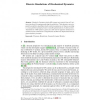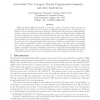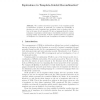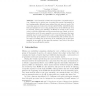DNA
2007
Springer
14 years 7 months ago
2007
Springer
Reliable DNA computing requires a large pool of oligonucleotides that do not produce cross-hybridize. In this paper, we present a transformed algorithm to calculate the maximum wei...
DNA
2007
Springer
14 years 9 months ago
2007
Springer
Abstract. Metabolic P systems, shortly MP systems, are a special class of P systems, introduced for expressing biological metabolism. Their dynamics are computed by metabolic algor...
DNA
2007
Springer
14 years 9 months ago
2007
Springer
We introduce staged self-assembly of Wang tiles, where tiles can be added dynamically in sequence and where intermediate constructions can be stored for later mixing. This model a...
DNA
2007
Springer
14 years 9 months ago
2007
Springer
Abstract. A major challenge in nanoscience is the design of synthetic molecular devices that run autonomously and are programmable. DNA-based synthetic molecular devices have the a...
DNA
2007
Springer
14 years 9 months ago
2007
Springer
While algorithmic DNA self-assembly is, in theory, capable of forming complex patterns, its experimental demonstration has been limited by significant assembly errors. In this pa...
DNA
2007
Springer
14 years 9 months ago
2007
Springer
We consider theoretical properties of the template-guided recombination operation. In particular, we consider the decidability of whether two sets of templates are equivalent, that...
DNA
2007
Springer
14 years 9 months ago
2007
Springer
In search for “realistic” bio-inspired computing models, we consider asynchronous spiking neural P systems, in the hope to get a class of computing devices with decidable prope...
DNA
2007
Springer
14 years 9 months ago
2007
Springer
Abstract. Gene assembly in ciliates is an impressive computational process. Ciliates have a unique way of storing their genetic information in two fundamentally different forms wi...




